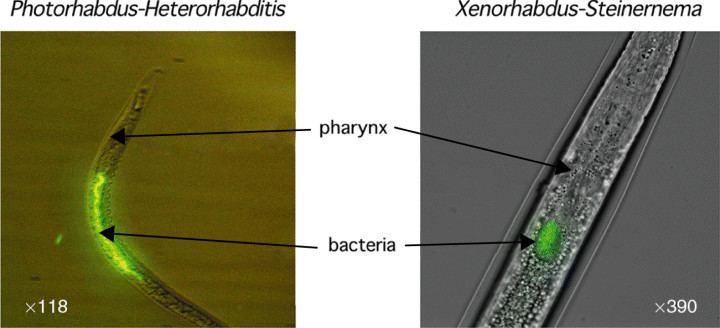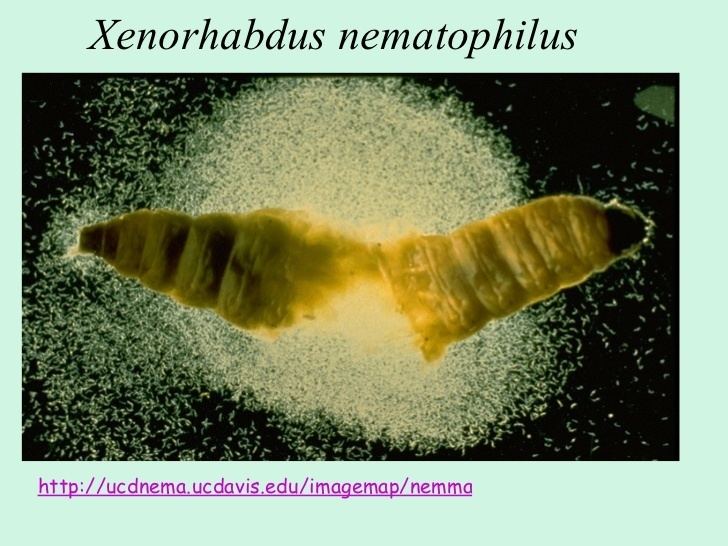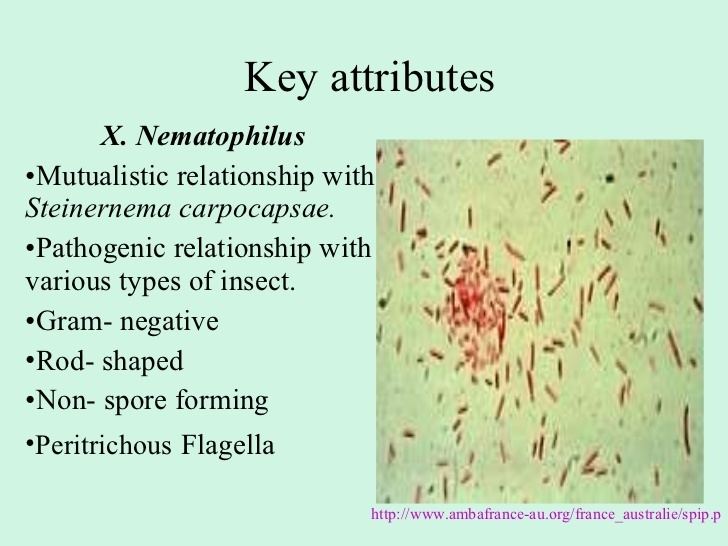Phylum Proteobacteria Order Enterobacteriales | Rank Genus Family Enterobacteriaceae | |
 | ||
Genus Xenorhabdus; Thomas & Poinar, 1979 Similar Photorhabdus, Steinernema, Heterorhabditis, Photorhabdus luminescens, Heterorhabditis bacteriophora | ||
Xenorhabdus is a genus of motile, gram-negative bacteria from the family of the Enterobacteriaceae. It has the particularity that all the species of the genus live in symbiosis with soil entomopathogenic nematodes from the genus Steinernema.
Contents
Although no free-living forms of Xenorhabdus have ever been isolated outside of the nematode host, the benefits for the bacteria are still unknown. However, it has been demonstrated that the nematode can't establish within his insect host without the bacteria.

The tripartite Xenorhabdus-nematode-insect interaction represents a model system in which both mutualistic and pathogenic processes can be studied in a single bacterial species. In laboratory, some species are virulent directly injected within the insect host, whereas others species need the nematode to penetrate into the insect.

Medical vocabulary what does xenorhabdus mean
Lifecycle

- In the non-infestant-stage nematode living in the soil, Xenorhabdus spp. are carried in a specialized region of the intestine, termed the receptacle.
- At the third-stage of development, the infective juvenile (IJs) invade the hemocoel of susceptible insect hosts.
- The bacteria are released in the insect hemocoel, where they overcome the insect's defense systems and produce numerous virulence factors such as hemolysin and cytotoxin. They participate in suppressing insect immunity and killing the host.
- The bacteria proliferate to high levels in the insect cadaver and produce diverse antimicrobial compounds that suppress the growth of antagonistic microorganisms. Xenorhabdus spp. also secrete an array of exoenzymes that stimulate macromolecular degradation, the products of which, together with the bacteria themselves, are thought to provide a nutrient base for nematode growth and reproduction.
- When nematode numbers become high and nutrients become limiting in the insect cadaver, nematode progeny re-associate with bacteria and differentiate into colonized, non-feeding IJs that emerge into the soil to forage for new hosts.
Biological pest control

The mutualistic association between Xenorhabdus and Steinernema represent an insectidical complex, active against a large range of insect pests. Indeed, the complex is used in biological pest control, and is very efficient against insects such as Spodoptera exigua (Lepidoptera), Cydia pomonella (Lepidoptera), Leptinotarsa decemlineata (Coleoptera), Tipulidae family (Diptera). Xenorhabdus nematofila is the most used species in biological control, in association with Steinernema carpocapse and Steinernema feltiae.

The pathogenicity of the complex is "species-specific", which means that the complex can only be active against a specific range of insects.
The Steinernema-Xenorhabdus association is currently sold as biocontrol agent by private companies, like Biobest, SUMI AGRO, and Biosafe.
Perspectives
A study carried out by Furgani G. & Al suggests that the antibiotic compounds produced by Xenorhabdus to preserve the insect cadaver from others bacteria may be used in the aim of controlling mastitis caused by bacteria. Indeed, Xenorhabdus budapestensis, X. szentirmaii and X. nematofila appear to be efficient against pathogens such as Staphylocuccus aureus and Escherichia coli.
